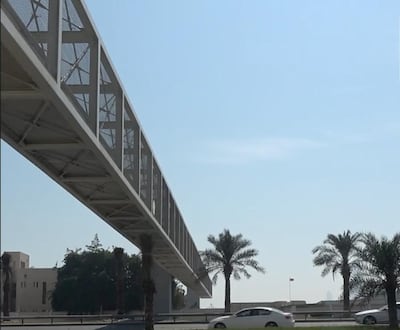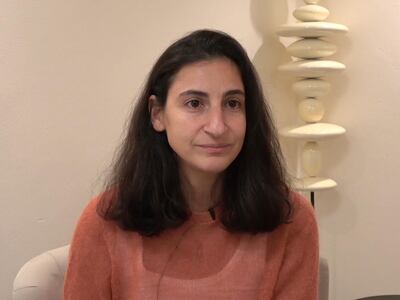Until recently, it was impossible to journey the entirety of Bahrain's Pearling Path on foot.
The serial Unesco World Heritage Site was disconnected from the coastline via a highway, but that has now changed with the opening of a new pedestrian bridge.
Now, it’s possible for visitors to walk continuously from the coastline of Bu Maher – the last remaining coastline of Muharraq – to Halat bu Maher, and then along the rest of the 3.5-kilometre pathway, taking in all 17 heritage houses and the fort that make up this vast site. Three oyster beds in Bahrain’s northern waters are also part of the trail.
The bridge, which is located at the southern end of the Pearling Path, restores the link between the old city and the shores of the Bu Maher Fort, and was designed by Kersten Geers and David Van Severen in collaboration with Ismail Khonji Architects.
Visitors can now venture to the fort via the bridge between noon and 6pm, while Muharraq residents can use it to cross the Khalifa Al Kabeer Highway at any time.
Previously, tourists wanting to see the Bu Maher Fort had to pay 1 Bahraini dinar ($2.6) to take a boat from the Bahrain National Museum.
What else is still to come
"The [Pearling Path] project has been in the works for 10 years now, at least," Noura Al Sayeh, the project director at Bahrain Authority for Culture & Antiquities, tells The National.
“[It] is, of course, referencing the pearling economy for which Bahrain was known and Muharraq more specifically as the capital of pearling in the Arabian Gulf,” she explains.
“Muharraq was known as a single-product economy, which means that everything you see built in [the city] until the 1930s and 1940s has been built in direct relation to the pearling economy.”
This, she explains, is what won the area its inscription on the Unesco World Heritage List in 2012. The Pearling Path is one of the country's three Unesco-listed heritage sites.
"Pearling is such an important part of the national identity of Bahrain," says Al Sayeh.
While tourists and residents have been able to explore the pathway for years, the project team has been busy overseeing the urban regeneration and rehabilitation of the area for the past decade.
In 2015, following financing from Saudi Arabia’s Islamic Development Bank, the team finally awarded work to a slate of contractors and conservation architects in order to complete the job. It was important to find the right people, as they need to be careful to ensure all urban and historic centres are the same as when they were inscribed, explains Al Sayeh.
The pedestrian bridge is the latest development on the project, after the recently completed Visitor and Experience Centre in Souq Al Qaysariya and the renovated Nukhidhah House, the majlis of boat captain Jassim Ajaj that was built in the 1920s.
See more from the ongoing works in Souq Al Qaysariya in the gallery below:
Now, all that's left to do is complete the regeneration and rehabilitation of the other historic structures, as well as implement public parks and parking spaces, and oversee the upgrade of shops in the souq.
“We hope to have completed the project by the end of this year,” says Al Sayeh.
The Pearling Path’s Visitor and Experience Centre
This aspect of the project was finished in 2019. Located in the heart of Muharraq, which is the former capital of Bahrain, the Visitor and Experience Centre was designed by Valerio Olgiati architects and overseen by Emaar Engineering. It incorporates the ruins of Amarat Yousif Ali Fakhro, a structure built in the 1930s that had fallen into disrepair.
The new centre is meant to act as a community hub and includes an exhibition space and workshop areas, as well as the pearling heritage archive and library, and conference facilities, according to the Pearling Path's official website.
"The building is conceived as a uniting roof structure that houses the visitors' centre, as well as providing protection to the ruins and a shaded space of gathering for the visitors and the local community," the website explains.
"The climate under the roof is improved by reintroducing to the city a series of 15 wind towers. A forest of thin columns holds the roof, the height of the roof and the grid of the columns are of a different logic to the archeological ruins, enabling the visitors to easily distinguish between the two systems, that of the ruins and that of the project."
The structure provides an entrance to the Pearling Path and links Avenue 10 to Tujjar Avenue and the historic souq of Muharraq.
“The entire Pearling Site can therefore be understood as not only the foyer of the visitors’ centre, but also the foyer of the city of Muharraq."
How the pandemic has affected this project
The implementation of the project is complex enough, but the onset of the pandemic presented new challenges the BACA team were not prepared for.
“The difficulties of Covid-19 and the lack of ability to travel have highlighted mostly the need to develop and maintain very specific attributes to touristic destinations,” Al Sayeh says.
“While the travel restrictions related to coronavirus are still being released, we really need to think about why would someone travel to somewhere else, what is this motivation and what will make someone want to get on a plane?
“I think that to travel somewhere to see something you do not have at home remains very valuable ... This makes it even more important for us to develop this project in a very local and specific way,” she adds.
“I think maintaining that specificity, maintaining what is local, what is authentic, what is real, what is rooted in local heritage and history, will be even more important than before.”







